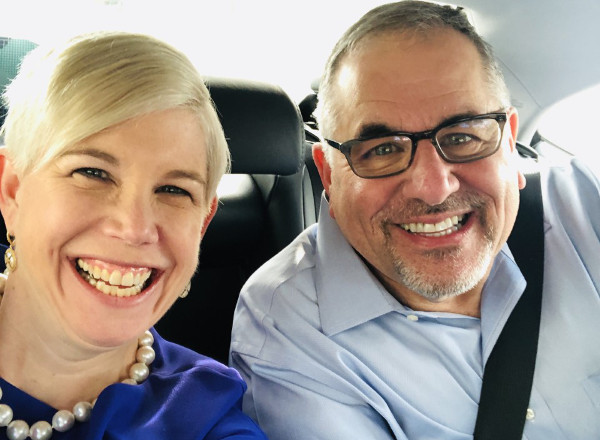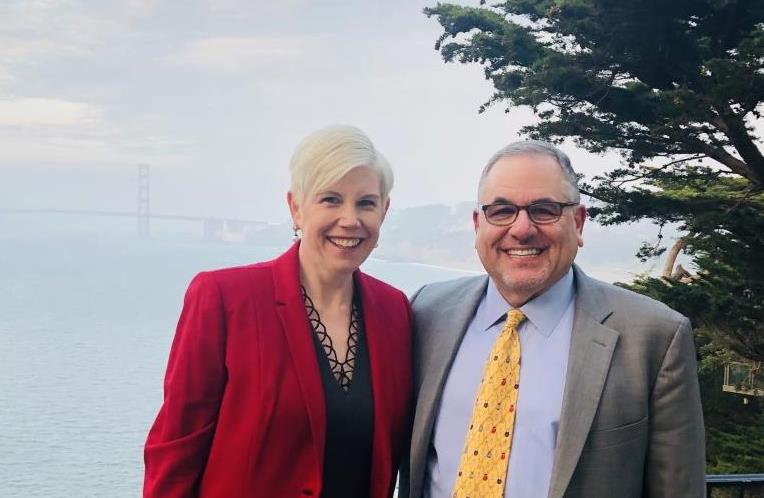Secrets to a Successful Merger from Philanthropy Leaders Who've Been There
Jenny Love
Published: 03/05/2020

Shannon Duval and Fred Najjar share a lighter moment during the merger experience.
Mergers are not for the faint of heart. According to Harvard Business Review, 70 to 90 percent of them fail, and at the very least they cause significant upheaval for all involved.
So when you come across two individuals who have not only survived the merger of the philanthropy functions at two of the largest Catholic health care systems in the United States but still find time to enjoy the occasional vodka tonic together, you need to talk to them.
Fred Najjar, Chief Philanthropy Officer at CommonSpirit Health, and Shannon Duval, Deputy Chief Philanthropy Officer, had been knitting together Dignity Health and Catholic Health Initiatives' 80 foundations for more than a year by the time the merger between the two was finalized in January 2019 to form CommonSpirit. A year later, they had their best fundraising year ever. Here's how they did it.
How did you feel when you found out you were going to have to make this transition?
Shannon: There's the normal human response of change. But Fred and I are very good colleagues, so I felt more excitement about the once-in-a-lifetime career opportunity to help co-create philanthropy for the largest nonprofit health system in the country.
Fred: I would say the same thing. Because we knew each other [from HSPLG and AHP], it gave us a jumpstart in terms of the work that we were going to do.
When you started working on the merger at the beginning of 2018, what were the biggest issues you had to tackle to make it go smoothly?
Fred: Being available to consult with each other was critical. We made it a priority to stay in good communication early in the discussion. We were on the phone with each other for one or two hours every day for a year. It allowed us to be more nimble when we had to make decisions. It's not like we didn't have other stuff to do, but we knew this was important work.
Shannon: The year-long process was facilitated by McKinsey. Quite often we were the first people done with whatever assignment they gave us, because we had invested the time on the front end to be in lockstep.
You were each in the top leadership position at your respective organizations before the merger. Now Shannon reports to Fred. How did you handle that transition?
Shannon: The initial leadership decision was made by our CEO. From there, Fred was very magnanimous and inclusive. He included me to build the new organizational structure. In terms of the division of duties, Fred did a great job of saying, OK, what is the best use of his skills and abilities and knowledge, and then where can I add value and complement his leadership?
Fred: Who was in the leadership role was not clear until we'd been working together almost a year. We had been getting feedback that the leadership thought very highly of both of us, which is very flattering. But there was a level of anxiety. We worked really hard through that. I would say 99.9 percent of the decisions that were made around philanthropy were made together.
Were there differences between the cultures of Dignity Health and Catholic Health Initiatives? How did you bridge those gaps?
Shannon: One difference was that Dignity operated across three states. Catholic Health Initiatives had been across 18 states. We had to figure out how to create a best-practice culture when you have to get on an airplane to go see your staff. It’s been fun to think about how we do that most effectively and in an inspirational way. I love to be eyeball-to-eyeball for leadership mentoring and accountability conversations, but we have to be creative given the breadth of the states we cover.
Fred: We’ve got foundations in very large metropolitan areas like San Francisco down to critical access hospitals in North Dakota. We had to make sure that we were not tone deaf and trying to treat everybody as the same. One thing that was very helpful in our early part of connecting was the travel. Within the first six months, we tried to get to many different areas so that we were known to our foundations.
Shannon: There's not some magic wand. Just one foot in front of the other. The culture has woven together because of the ultimate shared values. When there’s been things where we disagree, we come back to that center that our values are the same. Through that we can get to the solution.
It’s been a year since the merger was finalized. Let’s start with the good news. How have things exceeded your expectations?
Fred: I was fearful that fundraising could have been impacted, but we had our best fundraising year in our history. The fear of any distraction because of the merger didn't happen. I feel really good about that.
Shannon: For me the biggest positive has been the people. To a person, the excitement has overshadowed any fear. It’s wonderful to know that a philanthropy officer in Des Moines, IA, is calling the chief of philanthropy in Redding, CA, because they're working collaboratively. We always joked that if we're coming together, it shouldn't be one plus one equals two. It should be one plus one equals seven or 10. And in the people section, that's surpassed my wildest expectations.
What are the big challenges that you're tackling next?
Fred: Well, the reporting structure is probably not where Shannon and I would like it to be. To maximize philanthropy at local, regional, and national levels, and to realize greater efficiencies, it is our recommendation that the organizational structure for fundraising throughout CommonSpirit Health be restructured. The new model would move from the current decentralized model to a centralized/regionalized model with Chief Philanthropy Officers reporting under Philanthropy, having continued dotted-line relationships to local hospital leadership. We were asked to hold off on this type of change in the first year of the alignment and consider it for the future. In short, we work from a model of “influence” versus authority and accountability. As you can imagine, this is very time consuming when you have 80 foundations.
Shannon: We're looking for the future best practice of how we go further, faster with philanthropy. What's the right structure for that? Across the [CommonSpirit] system, there's only about 300 professionals working in philanthropy. Compare that to my friend at [a university] who has 75 people. As we’re having this trajectory of growth, in our opinion, we should have resources added, because we’re going to continue to grow revenue for the mission. We need to continue to educate [senior leadership].

What advice would you give a peer about to embark on the journey you’ve just completed?
Shannon: There will probably be times when you're drinking from the firehose. Try to stay focused on the long game and the full potential of coming together, and not on the day-to-day details of alignment. Even if there are some tough conversations or heavy days, it will be worth it if you are focused the end game.
Fred: View your new colleagues during the merger as colleagues, not adversaries. Seek them out early. Spend personal and professional time with them. Continue to get to know each other and have fun with each other, not letting this be a burden.
Looking back, I feel blessed that I went through this journey with Shannon for sure.
Shannon: We do kind of have a mutual admiration society.
Fred: Yeah, I agree. We like each other a lot.